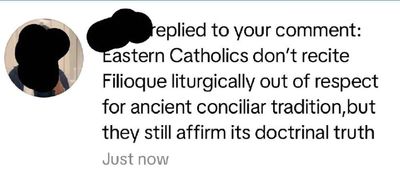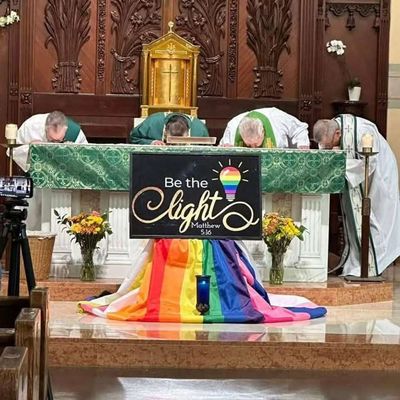
Анатолий Шарий

Реальний Київ | Украина

Лёха в Short’ах Long’ует

Мир сегодня с "Юрий Подоляка"

Труха⚡️Україна

Николаевский Ванёк

Инсайдер UA

Реальна Війна | Україна | Новини

Лачен пише

Анатолий Шарий

Реальний Київ | Украина

Лёха в Short’ах Long’ует

Мир сегодня с "Юрий Подоляка"

Труха⚡️Україна

Николаевский Ванёк

Инсайдер UA

Реальна Війна | Україна | Новини

Лачен пише

Анатолий Шарий

Реальний Київ | Украина

Лёха в Short’ах Long’ует

Cope for the Pope 🇻🇦
Unam Sanctam : A declaration that it is necessary for salvation that every person be subject to the Roman Pontiff.
Popes advocate for World Peace & global religious unity.
Despise their flattery, resist Ecumenism, remember the fact of Antichrist coming.
Popes advocate for World Peace & global religious unity.
Despise their flattery, resist Ecumenism, remember the fact of Antichrist coming.
记录
29.04.202523:59
93订阅者12.02.202523:59
0引用指数09.05.202505:01
56每帖平均覆盖率28.02.202514:54
21广告帖子的平均覆盖率10.05.202507:03
21.43%ER10.04.202507:38
60.87%ERR

09.05.202504:06
04.05.202521:53
06.05.202503:54
Rothschild loans to the Holy See refers to a series of major financial loans arranged between the Rothschild family and the Holy See of the Catholic Church.
Background
In the aftermath of the Napoleonic Wars, there was a return to the politics of throne and altar in Europe. Around this time, the Rothschild family of Jewish bankers from Frankfurt had arisen to a position of prominence as bankers. Scions of this family established themselves in several European power centers, including in Catholic countries, such as in Vienna in the Austrian Empire of Klemens von Metternich (for whom the Age of Metternich is named), and in Naples ruled by the Bourbon-Two Sicilies monarchy. One of the states to which sovereignty was restored by the Congress of Vienna was the Papal States, temporal domain of the Holy See. However, in the years following restoration, the finances of the Holy See declined.
In 1831, Cardinal Bartolomeo Cappellari was elected Pope Gregory XVI. The Rothschilds were considered reliable in conservative circles in Europe, because they had worked with the Austrian government to stabilize finances after the Napoleonic Wars. They also shored up the Bourbons in the Kingdom of the Two Sicilies, which bordered the Papal States, by helping finance their suppression of two attempted revolutions. That year there were rumours that Rome would reach out to the Rothschild family for a loan; the brothers James and Carl were initially wary, but both Austria (Metternich and Count Appony) and France (Casimir Pierre Périer and Horace François Bastien Sébastiani de La Porta) pressed the issue for Rome.[3] Initially, there was some resistance during the negotiations, particularly from the Roman government and Monsignor Antonio Garibaldi at Paris. However, Alessandro Torlonia (acting for the Holy See) held direct negotiations with James Mayer de Rothschild and thrashed out an agreement, signed on 30 November 1831. Thus in 1832 the Rothschilds’ agreement to provide a loan to the Holy See for £400,000 (equivalent to £4.7 million in 2023) came into force.
James Mayer de Rothschild, head of the French Banque Rothschild, became the official Papal banker. His Naples-based brother, Carl Mayer von Rothschild, geographically closer to Rome, went to meet with Pope Gregory XVI in January 1832. Here Carl Mayer was presented with the ribbon and star of the Sacred Military Constantinian Order of Saint George. It was customary for Catholics to show reverence for him whom they regarded as the Vicar of Christ, to kiss the Pope's feet when meeting him. As a Jew, Carl Mayer von Rothschild was permitted to simply kiss the ring on his hand instead. This outraged Catholic critics of the deal at the time. It even garnered a reference centuries later, by Philippe de Rothschild, a direct descendant of James and Carl, in his autobiography Milady Vine (1984).
A second loan occurred during the Pontificate of Pope Pius IX ("Pio Nono") in the early 1850s with the same members of the Rothschild family after the collapse of Giuseppe Mazzini's short-lived revolutionary Roman Republic and the restoration of the Papal States.
Background
In the aftermath of the Napoleonic Wars, there was a return to the politics of throne and altar in Europe. Around this time, the Rothschild family of Jewish bankers from Frankfurt had arisen to a position of prominence as bankers. Scions of this family established themselves in several European power centers, including in Catholic countries, such as in Vienna in the Austrian Empire of Klemens von Metternich (for whom the Age of Metternich is named), and in Naples ruled by the Bourbon-Two Sicilies monarchy. One of the states to which sovereignty was restored by the Congress of Vienna was the Papal States, temporal domain of the Holy See. However, in the years following restoration, the finances of the Holy See declined.
In 1831, Cardinal Bartolomeo Cappellari was elected Pope Gregory XVI. The Rothschilds were considered reliable in conservative circles in Europe, because they had worked with the Austrian government to stabilize finances after the Napoleonic Wars. They also shored up the Bourbons in the Kingdom of the Two Sicilies, which bordered the Papal States, by helping finance their suppression of two attempted revolutions. That year there were rumours that Rome would reach out to the Rothschild family for a loan; the brothers James and Carl were initially wary, but both Austria (Metternich and Count Appony) and France (Casimir Pierre Périer and Horace François Bastien Sébastiani de La Porta) pressed the issue for Rome.[3] Initially, there was some resistance during the negotiations, particularly from the Roman government and Monsignor Antonio Garibaldi at Paris. However, Alessandro Torlonia (acting for the Holy See) held direct negotiations with James Mayer de Rothschild and thrashed out an agreement, signed on 30 November 1831. Thus in 1832 the Rothschilds’ agreement to provide a loan to the Holy See for £400,000 (equivalent to £4.7 million in 2023) came into force.
James Mayer de Rothschild, head of the French Banque Rothschild, became the official Papal banker. His Naples-based brother, Carl Mayer von Rothschild, geographically closer to Rome, went to meet with Pope Gregory XVI in January 1832. Here Carl Mayer was presented with the ribbon and star of the Sacred Military Constantinian Order of Saint George. It was customary for Catholics to show reverence for him whom they regarded as the Vicar of Christ, to kiss the Pope's feet when meeting him. As a Jew, Carl Mayer von Rothschild was permitted to simply kiss the ring on his hand instead. This outraged Catholic critics of the deal at the time. It even garnered a reference centuries later, by Philippe de Rothschild, a direct descendant of James and Carl, in his autobiography Milady Vine (1984).
A second loan occurred during the Pontificate of Pope Pius IX ("Pio Nono") in the early 1850s with the same members of the Rothschild family after the collapse of Giuseppe Mazzini's short-lived revolutionary Roman Republic and the restoration of the Papal States.


10.05.202522:47
03.05.202507:15
08.05.202518:29
‼️New pope Robert Prevost covered for a pedo priest who resided by a Catholic elementary school
08.05.202518:28
https://www.lifesitenews.com/opinion/could-cardinal-prevost-be-the-first-american-pope/
the conclusion of their assessment is negative.
the conclusion of their assessment is negative.
01.05.202518:39
The Vatican invited transgender individuals, migrants, and prisoners to participate in the burial ceremony of the pontiff at the Basilica of Santa Maria Maggiore.
https://spzh.eu/en/news/85984-the-pontiffs-funeral-to-be-attended-by-transgender-individuals
https://spzh.eu/en/news/85984-the-pontiffs-funeral-to-be-attended-by-transgender-individuals
登录以解锁更多功能。

